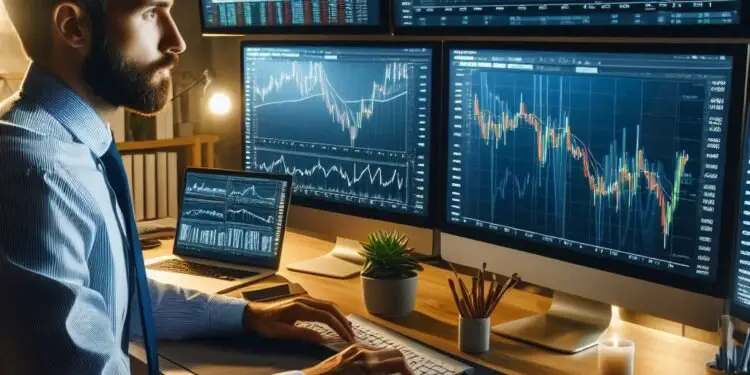Thinking approximately jumping into the arena of forex buying and selling but don’t understand where to start? You’re no longer alone—and you’re in the right place. how to trading in the forex market
So, What Exactly Is Forex Trading?
Let’s spoil it down.
The foreign exchange marketplace—generally known as forex or FX—is wherein humans purchase and promote one-of-a-kind currencies. Think of it like replacing dollars for euros before a trip overseas, besides here, buyers are seeking to profit from how foreign money values cross up or down.
It’s the most important and maximum liquid market in the world, with trillions of greenbacks traded each day. Yes, trillions—with a “T.” And not like the inventory market, it runs 24 hours a day, 5 days per week.
Why People Are Drawn to Forex?
Low Barrier to Entry: You don’t need lots of greenbacks to begin.- High Liquidity: You can buy and sell in seconds.
- Open 24/5: Trade when it suits your time table—whether or not you’re a night time owl or early chook.
- Leverage Opportunities: Some brokers will let you manage massive positions with exceptionally small quantities of cash (even though that includes higher danger).
But here’s the fact: forex buying and selling isn’t a get-rich-quick scheme. It calls for patience, strategy, and self-discipline.
Step 1: Understand the Basics
Before setting your money on the road, make certain you understand the important thing terms:
- Currency Pair: You’re continually trading two currencies right now. For example, EUR/USD (euro vs. US dollar).
- Pip: Short for “percentage in factor.” It’s the smallest price circulate a couple can make.
- Leverage: Borrowed cash that amplifies each your potential profits and losses.
- Spread: The distinction between the shopping for (ask) and selling (bid) charge.
- Lot: The length of your change. One fashionable lot = one hundred,000 devices of the bottom forex.
Step 2: Choose a Reliable Forex Broker
This is where a variety of novices slip up.
Not all brokers are created equal. Some have hidden prices, shady practices, or negative customer support. Here’s what to look for:
✅ Regulated by way of a good financial authority (like the FCA, ASIC, or CFTC)
✅ Low spreads and transparent charges
✅ Easy-to-use buying and selling platform (like MetaTrader four or five)
✅ Demo debts to exercise with
✅ Responsive assist—due to the fact trust me, you’ll want it sooner or later
Tip: Avoid offshore agents until you in reality recognise what you’re doing.
Step 3: Practice With a Demo Account
Before risking actual cash, exercise with virtual cash. Most agents provide demo bills wherein you may check the waters with none financial chance.
Use this time to:
- Get familiar with how orders paintings
- Try special strategies
- Understand how fast things can exchange
It’s tempting to hurry in, however the demo section is in which you build your basis.
Step 4: Build Your Trading Plan
Let’s be actual—winging it gained’t cut it.
A strong buying and selling plan keeps your emotions in check and helps you’re making selections based totally on good judgment, now not panic.
Here’s what your plan need to include:
- Trading strategy: Are you a scalper (brief trades) or a swing dealer (keeping for days)?
- Risk control policies: Never chance more than 1-2% of your account in line with change.
- Entry and exit factors: When will you input a trade—and how will you realize it’s time to get out?
- Stop-loss and take-income ranges: Always set limits to protect your capital.
Step 5: Start Small, Stay Consistent
When you’re geared up to head stay, begin with a small quantity. Even $100 can educate you lots about your trading behavior.
Don’t fall for the Instagram traders displaying off luxury vehicles and big income. Real buyers attention on hazard management, consistency, and lengthy-time period growth.
Common Mistakes Beginners Make
Let’s prevent a few heartache. Here are some mistakes to avoid:
❌ Over-leveraging: Just due to the fact you may use 100x leverage doesn’t imply you ought to
❌ Trading without a stop-loss: This is a recipe for catastrophe
❌ Chasing the marketplace: Reacting emotionally to every movement leads to terrible choices
❌ Ignoring the information: Global occasions and economic reviews pass foreign money prices
❌ Lack of patience: It’s no longer about one lucky trade—it’s approximately regular performance
Technical vs. Fundamental Analysis
Two important schools of idea guide maximum traders:
🔍 Technical Analysis
Focuses on charts, styles, indicators, and rate moves.
Common tools:
- Moving Averages
- RSI (Relative Strength Index)
- MACD
- Support and resistance zones
📊 Fundamental Analysis
Looks at the bigger photograph—interest quotes, inflation, employment records, political stability.
For example:
- If the U.S. Fed increases interest prices, the USD may additionally strengthen.
- If the Eurozone faces political instability, the EUR might weaken.
Most traders subsequently use both to make informed decisions.
The Psychology of Forex Trading
This would possibly wonder you, but your mindset matters simply as an awful lot as your approach.
Fear, greed, overconfidence—those feelings can break your method if you’re not cautious.
💡 Pro Tip: Keep a buying and selling magazine. Write down why you entered a change, what took place, and how you felt. Over time, you’ll analyze what works and what doesn’t.
How Much Money Can You Make?
Let’s be honest: Forex trading is not a guaranteed way to make cash.
Some humans make consistent returns; others lose their entire debts.
The key distinction? Discipline and schooling.
If you’re wondering you’ll double your money each week, this might not be the space for you. But if you’re inclined to research, exercise, and develop, forex can emerge as a valuable talent.
Final Thoughts: Start Slow, Think Long-Term
You don’t need to become a complete-time trader overnight.
Open a demo account.
Learn the language of the marketplace.
Find a strategy that fits your character.
And by no means stop studying.
Remember: Success in forex isn’t about success. It’s about guidance, exercise, and staying power.
So, if you’re prepared to take that first step, take it with purpose. Start small. Stay constant. And who is aware of? A year from now, you may look lower back and be proud of how a ways you’ve come.












